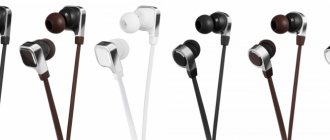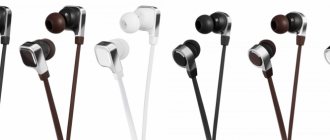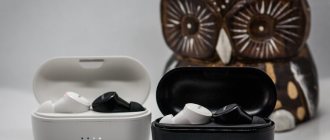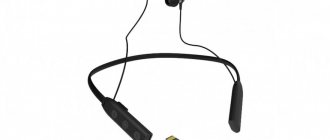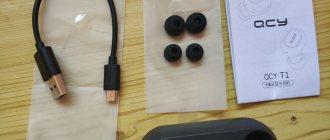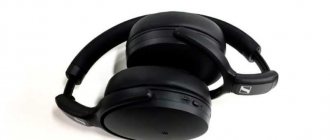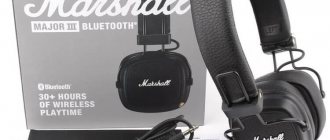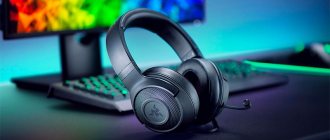Is it time to buy headphones again? In a store, do you feel confused and don’t understand why prices for seemingly identical devices differ several times over? How to make the right choice and buy the best possible budget headphones? Of course, you can contact a consultant in the store, but everyone understands that sellers pursue their own goals.
What now, waste precious time and study technical literature? There is a solution! This article, written in clear human language, discusses all the main characteristics and also presents the best models based on your budget. Fantastic? No, see for yourself.
Principle of operation
We will not delve into the technical details; we will only briefly analyze the operating principle of the devices in question.
Sound has a wave nature, so the main element of the headphones is a sound emitter, which creates mechanical vibrations that are transmitted to the membrane and perceived by the eardrum. If sounds are transmitted through one emitter, such headphones will be called single-band, if through 2 or more - multi-band. In the latter case, each emitter is tuned to its own frequency range, resulting in higher quality sound. The signal to each cup can be transmitted either through one channel or through two or more, creating spatial sound.
Main characteristics
- Sensitivity – determines the volume of the output sound. Surely everyone has encountered the fact that at the same volume settings, some headphones produce louder sound than others. This means their sensitivity is higher. It is measured in decibels (dB).
- Power - the higher this parameter (measured in watts - W, mW), the richer the sound will be. However, more power puts a strain on the player's amplifier, so with more powerful devices the battery will drain faster. This is important to consider if you are going to listen to music outside the home, away from the mains.
- Resistance or impedance - affects the clarity of playback. Measured in ohms (ohms). Each amplifier has an optimal impedance range; for example, most portable devices are designed for impedance in the range from 16 to 32 ohms, so units of this impedance level are more suitable for smartphones. You can use headphones with a higher level, but this will drain the battery faster. Professional headphones, many of which cost several hundred dollars, have an impedance in the hundreds of ohms.
- Frequency range - the larger it is, the better quality sound you will get. The unit of measurement is hertz (Hz). The average figure is 18 Hz – 20 kHz.
- Distortion factor - measured as a percentage, the lower it is, the better. However, manufacturers rarely indicate this parameter.
One-way headset
A one-way headset is an excellent option for professional work. Such devices often have a high-quality microphone, which makes negotiations with their help more comfortable.
Plantronics RIG 100HX
This is a full-size gaming headset with an earpiece on one side. It has an interesting design, which provides good ventilation, which eliminates any inconvenience even with prolonged use. The bow here is detachable, this is made for ease of transportation. The microphone is not removable, but it has a flexible stem so you can adjust it to any position.
The design of the earphone is open - this eliminates the “air cushion” effect, but, on the other hand, has a negative effect on eliminating external noise. Connection is made via 3.5. The cable contains a volume and microphone control panel. Sound characteristics are standard: frequency range from 20 to 20,000 Hz, impedance - 32 Ohms, sensitivity - 111 dB. The model weighs 110 grams, which is quite light for this class of devices.
Advantages:
- good ergonomics;
- a light weight;
- convenient control;
- good voice transmission.
Flaws:
- The headphones are quite quiet;
- There is no sound insulation.
Sennheiser PC 2 CHAT
These are professional on-ear, single-sided headphones that are perfect for office use. The model has a light weight of 55 grams, a two-meter cable with two 3.5 connections. She has a noise-canceling microphone and it is movable. Frequency range – 42 – 17000 Hz, resistance – 32 Ohms, sensitivity 95 dB.
Advantages:
- good voice and sound transmission;
- comfortable fit;
- long cable.
Flaws:
- The cord is very thin.
Types of headphone designs
The design determines exactly how the devices will be positioned in your ear. This is a matter of convenience, habits and even lifestyle. Let's look at the main types.
- Invoices are the oldest type, one might say, a classic of the genre. Gadgets of this type are placed on the auricle and pressed against it. This creates a major disadvantage: the device puts pressure on the ears and causes discomfort when worn for a long time. You will also have to carefully choose your headdress.
- Full-size - these headphones fit tightly to the head and seem to wrap around the ears. Full-size units have the highest sound quality, they are comfortable, and high-quality materials are used in the design of the housing. Disadvantages: relatively high price, bulkiness and the need to select appropriate headgear.
- Earbuds are miniature devices that are inserted into the ear. This is the most common type today, and this is understandable: such an item is very comfortable to wear, they are inexpensive, however, the sound quality is not the best, reliable fixation is not ensured, the “pills” can fall out when moving, and extraneous noise can be heard. However, in some situations the latter is even a plus: with them you are unlikely to pass the required stop.
- Insertable (“plugs”) - these units also have a miniature size, they are located directly in the ear canal, the sound quality is higher than that of earbuds, they are better fixed and protect from external sounds. But they put a lot of stress on the hearing aid, do not allow the organs to breathe, which is especially important in the hot season, and require regular cleaning.
Features of the balanced circuit
To understand the essence of a balanced circuit, you can take an amplifier that has additional phono stage and DAC modules. That is, one where the full path is presented. Looking inside the device, you can understand that the connection to the amplifier is carried out through 3-pin audio inputs/audio outputs in XLR connectors. The circuit contains 3 pulse conductors:
- "minus";
- "plus";
- .
The signal in an unbalanced circuit is passed through only the “plus” and “ground”, while in a balanced circuit there is also a beam - a kind of response of the “plus” pulse. The amplitude of the signal is doubled, a useful effect is obtained as a result of the fact that the noise distortions bursting into the sound path are unipolar. When the pickup hits the “plus” arm in phase, then in antiphase it is announced in the “minus” arm. Mutual cancellation of extraneous noise occurs, and the sound remains clear.
In a balanced-type amplifier, according to the circuitry, a single channel is identical to two channels of the opposite type. Instead of a single operational transistor operating between ground and plus, symmetrical pairs of such devices are used. One of them functions in the “plus” shoulder, the other predominates in the “minus”, and “earth” is the middle point among them.
In simple terms, you can turn one stereo amplifier into mono amplifier by amplifying the “minus” arm with a positive right or left channel. Thus, inside the device there is a pair of audio paths with symmetrically distributed components.
An important feature: in the circuit, each channel has its own “ground”, not connected to the grounding of another channel. In contrast, in an unbalanced circuit, ground is common and all channels are amplified in one chip/tube.
What else should you pay attention to?
- Acoustic design is determined by how the emitter is located in the cup: if it is hermetically closed from the outside, then this is a closed type. If there is fabric or other air-permeable material on the outside, it is open. In the latter option, the sound will be more spacious, but people around will also “enjoy” the sound. The same is true in the opposite direction: the closed type provides better protection from extraneous signals.
- Signal transmission method - wired or wireless. In the latter case, the signal travels via radio waves (Bluetooth, etc.) or using infrared radiation. Wireless headphones are more expensive than their wired counterparts in terms of sound quality.
- Plug – pay attention to which connector the playback device has, and purchase the appropriate headphones or purchase an adapter.
- The presence of a volume control on the headphones themselves will provide the ability to adjust this parameter without the participation of the main gadget.
- The material of the ear pads is the cushions directly adjacent to the ear. Various fabrics are used: both the cheapest materials and the most expensive. Comfort when using headphones directly depends on the quality of the material.
- Cable length depends on how the device is used. For example, if you plan to connect your headphones to your TV, the appropriate length of wire will ensure you are comfortable while watching movies and TV shows. A cable that is too long will cause discomfort when using devices outdoors.
Closeness to truth
During testing, I found a song that was perfect for demonstrating this difference in sound: “Everything” – Wasis Diop from the soundtrack of the film “The Thomas Crown Affair”. Moments where the backing vocalists do something like “oh-oh-oh” in the left and right channels, echoing the main vocals.
The owner of balanced headphones cannot do without adapters
With a balanced connection, the volume, audibility and intelligibility of the main and backing vocals were almost equal, and the backing vocalists were widely spaced. With unbalanced mode, attention is focused on the main vocal, which sounds clearer; the backing vocalists are closer to the center and dissolve somewhere in the general musical background.
Branded cable from Sennheiser headphones. Lest you think that balanced headphones are the preserve of tweakers, do-it-yourselfers and other enthusiasts
A reference system consisting of a Schiit Audio Yggdrasil DAC, a Schiit Audio Ragnarok amplifier and Sonus Faber Olympica III acoustics helped determine which of the two options corresponds more to the truth. On tracks that were completely different in the nature of the recording, the sound stage that was built when the headphones were connected in a balanced manner was as close as possible to what I heard when listening to music using acoustics.
Top best headphones under 300 rubles
Remax RM-515
pros
- “soft” sound;
- Beautiful design;
- replaceable ear pads (3 tips included);
- have a microphone.
Minuses
- quiet bass;
- thin cable;
- inconvenient volume control.
From 299 ₽
Dialog ES-F57
pros
- 3 sizes of nozzles included;
- flexible, reliable cable;
- good sound insulation;
- multifunctional control button;
- have a microphone.
Minuses
- low sound quality.
From 180 ₽
Philips SHE1350
pros
- reliable L-shaped plug fastening.
Minuses
- poor sound insulation;
- low sound quality;
- short cable.
From 170 ₽
Note: More suitable for listening to audiobooks.
SmartBuy WOW
pros
- there is a function to start/end a conversation;
- wide selection of colors;
- price-quality ratio;
- have a microphone.
Minuses
- thin cable.
From 141 ₽
Rating of the best headphones under 500 rubles
Sony MDR-EX15LP
pros
- the presence of three replaceable ear pads;
- surround sound.
Minuses
- rattling when listening to high notes;
- poor sound insulation;
- the movement of the wire when walking is transmitted to the speaker.
From 500 ₽
HARPER HV-303
pros
- there is an attachment - the occipital arch;
- interesting design;
- good sound quality;
- have a microphone.
Minuses
- the wire is connected to one cup.
From 415 ₽
Note: Designed for sports use.
Philips SBCHL145
pros
- comfortable;
- good build quality.
Minuses
- no volume control;
- faint sound;
- The ear pads wear out quickly, there are no spare ones included.
From 440 ₽
Note: More suitable for home use due to quiet sound.
Panasonic RP-HS46
pros
- lightness and compactness;
- there is a mount;
- good sound quality.
Minuses
- poor sound insulation;
- thin cable.
From 410 ₽
Panasonic RP-HJE125
pros
- good sound insulation;
- price-quality ratio;
- comfortable.
Minuses
- unreliable design;
- poor sound insulation.
From 340 ₽
What is the difference between balanced and unbalanced connection
There are several significant differences between balanced and unbalanced connections. So, the first has the following advantages:
- the presence of an additional conductor that helps control the difference between inversion and direct signals, transform inhibition in one of the media lines and reduce their impact on the positive impulse;
- suppression of common-mode interference generated by external noise by transporting information with a differential signal;
- The charge difference between the inversion and direct conductors, much greater than the potential difference between one signal and the ground of the unbalanced line, results in an analog signal that is resistant to cancellation (the signal-to-sound ratio is greater).
An unbalanced connection has a simpler implementation of transmitting and receiving devices and does not work over long distances (no more than 6 m). It is most often used when connecting a guitar amplifier or guitar.
Both connection methods are divided according to the method of use:
- unbalanced connection is applicable for interconnect connections within the radius of a single equipment rack;
- A balanced connection is used over impressive distances, for example, from the sound engineer’s console to the monitor speaker amplifiers.
- operation of a balanced connection, for example, in concert equipment, where rather long audio lines are used, passing through an environment saturated with interference.
Rating of the best headphones under 1000 rubles
Philips SHP2500
pros
- high-quality reproduction;
- convenient temple adjuster;
- The kit includes an adapter for a TV.
Minuses
- not very good sound insulation;
- An amplifier is required to fully develop the sound.
From 990 ₽
Note: the power is higher than that of analogues - 500 mW, this model has proven itself excellent among gamers.
SVEN AP-940MV
pros
- soft ear pads and headband;
- “surround” sound;
- good sound insulation;
- Includes 2 connectors - for use with a mobile phone and for connecting to a TV;
- have a microphone.
Minuses
- unreliable design, requires careful handling.
From 775 ₽
Perfeo PF-BTF
pros
- can be used via Bluetooth, range is up to 10 m;
- have a microphone;
- good battery;
- There is a folding mechanism - convenient to carry.
Minuses
- average sound quality;
- inconvenient folding mechanism;
- microphone is of average quality.
From 656 ₽
Note: A2DP, Hands free profiles are supported.
SVEN SEB-26BK
pros
- the kit includes a case;
- 3 sets of ear pads of different diameters;
- price-quality ratio;
- Microphone with adapter available.
Minuses
- no volume control;
- not very good playback quality;
- poor sound insulation.
From 520 ₽
Sony MDR-ZX310
pros
- folding design;
- light and compact;
- high-quality assembly.
Minuses
- average playback quality;
- average level of sound insulation.
From 990 ₽
Note: ear pad material is artificial leather.
Rating of the best headphones under 2000 rubles
Sony MDR-XB50AP
pros
- excellent sound;
- good sound insulation;
- case and 4 pairs of replaceable ear pads included.
Minuses
- simple design;
- thin wire;
- There is no volume button.
From 1484 ₽
Philips SHL4600
pros
- convenient lightweight folding design;
- balanced sound;
- interesting design.
Minuses
- no volume control;
- thin wire;
- Bass is a little weak.
From 1000 ₽
Sennheiser CX 300-II
pros
- surround, atmospheric sound;
- quality materials;
- excellent sound insulation;
- There are 3 pairs of replaceable ear pads available.
Minuses
- very soft wires;
- no volume control.
From 1250 ₽
Note: these headphones have an asymmetrical wire; for some, such wires cause inconvenience.
JBL T110BT
pros
- can be used via Bluetooth, operating time - up to 6 hours;
- microUSB cable, neck lanyard, replaceable ear pads included;
- There is a light indicator for battery charging.
Minuses
- "flat" sound.
From 1476 ₽
Note: A2DP, AVRCP, Hands free, Headset profiles are supported.
Top best headphones under 3000 rubles
Sony MDR-ZX660AP
pros
- high sound quality;
- reliable L-shaped plug;
- rotating design;
- have a microphone.
Minuses
- average sound insulation.
From 2489 ₽
Note: Maximum power is 1000 mW.
Audio-Technica ATH-M20x
pros
- high sound quality;
- good sound insulation;
- long durable wire;
- The kit includes a 6.3 mm adapter.
Minuses
- hard, putting a lot of pressure on the head;
- inconvenient to carry due to the long wire and static design;
- The wires between the cups are not hidden inside, but pass outside.
From 2989 ₽
Note: Maximum power is 700 mW.
Sony MDR-ZX220BT
pros
- can be used via Bluetooth, operating time - up to 8 hours;
- NFC support;
- long durable wire;
- give a high volume level;
- have a microphone;
- USB charging cable included.
Minuses
- wire missing;
- do not work while charging;
- "flat" sound.
From 2200 ₽
Degrees of perfection
One extremely interesting conclusion can be drawn from this: a device with a balanced headphone output does not necessarily have to be balanced throughout the entire audio path. In the situation with Schiit Audio Jotunheim, you can trace the entire circuitry and see with your own eyes that this device is truly balanced from start to finish. But nothing prevents you from making a USB DAC with a balanced headphone amplifier on one stereo DAC chip and with an unbalanced path inside. It is enough to install two bridge amplifiers at the output, and now we already have a balanced headphone output on an unbalanced device. This raises a completely logical question: does this make sense or is it a useless surrogate?
Manufacturers of amplifiers and sources do not have a common idea about the balanced connector, so headphone manufacturers adapt to everyone at once
Let's consider both options. Firstly, a fully balanced circuit design has an undeniable advantage, expressed in the low level of distortion that a symmetrical circuit provides. Secondly, in a fully balanced connection, the circuitry is symmetrical from start to finish. Both audio channels after the DAC or analog balanced input do not have a common “ground” and are not connected in any way, which guarantees maximum channel separation. In a circuit in which only the output stage is balanced (bridged), the channel separation will be less than in a fully balanced circuit, but still greater than in an unbalanced circuit.
Sennheiser headphones have two standard cables: balanced (connected, with a large jack) and unbalanced (lying next to the small 4-pin jack).
In both cases, dual amplifiers are used, which means doubling the output power. Thus, to obtain the same volume level, the amplifier will be half as loaded as a regular one. A double power reserve will have a positive effect on the sound dynamics and will become an additional means of improving quality, because at low load the amplifier has a lower level of its own distortion and noise, that is, it will sound cleaner and more detailed.
TEAC engineers decided that even with an unbalanced source, it would be a sin not to use dual amplifiers
A good example of implementing outputs in a balanced amplifier is the TEAC UD-503 model. Proprietary circuit design allows for the most efficient use of all possible use cases in any situation. With a balanced connection, the path is completely balanced.
Balanced circuitry is easy to recognize in any device: the same symmetry
With unbalanced, there is still an increase in the sound quality of balanced headphones thanks to proprietary technology with an active “ground”, when the signal turns into balanced at the input of the power amplifier. Finally, when connecting conventional three-pin headphones, each channel is amplified in bridged mode.
Rating of the best headphones under 5000 rubles
Pioneer SE-MJ553BT
pros
- work via Bluetooth, operating time up to 15 hours, range - up to 10 m;
- high-quality reproduction;
- multifunctional control (Multipoint);
- have a microphone.
Minuses
- there is no wire, there is no possibility of a wired connection;
- do not work while charging.
From 3590 ₽
Samsung EO-BG950 U Flex
pros
- work via Bluetooth, operating time up to 10 hours;
- multifunctional control (Multipoint);
- folding;
- 3 pairs of replaceable ear pads and USB cable included;
- have a microphone.
Minuses
- weak sound;
- low level of sound insulation.
From 3450 ₽
Note: A2DP, AVRCP, Hands free profiles are supported.
Beats EP On-Ear
pros
- excellent sound and noise insulation;
- multifunctional management;
- reliable;
- have a microphone;
- case included.
Minuses
- no replacement cable.
From 4999 ₽
Plantronics BackBeat FIT
pros
- work via Bluetooth, range up to 10 m;
- comfortable, hold well;
- convenient control;
- have a microphone.
Minuses
- low sound quality.
From 4990 ₽
Note: A2DP, AVRCP, Hands free, Headset profiles are supported.
Razer Hammerhead v2
pros
- high sound quality;
- good sound insulation;
- have a microphone;
- PC adapter included.
Minuses
- not found.
From 4890 ₽
Marshall Major II
pros
- rich sound;
- compact;
- removable cable, there is protection against bending of the wire;
- have a microphone.
Minuses
- tight headband;
- look cheap.
From 3870 ₽
Top best headphones under 6,000 rubles
Pioneer HDJ-700
pros
- clear sound;
- swivel cups;
- 2 cables included: 1.2 m (twisted), 1 m (straight);
- 6.3 mm adapter included.
Minuses
- not found.
From 5800 ₽
Audio-Technica ATH-M40x
pros
- excellent sound and noise insulation;
- high quality materials;
- 2 cables included: 1.2 - 3 m (twisted), 3 m (straight);
- 6.3mm adapter and storage case included.
Minuses
- relatively heavy weight.
From 5670 ₽
Sony MDR-XB950AP
pros
- excellent sound and noise insulation;
- reliable and convenient;
- have a microphone.
Minuses
- just one button on the control panel;
- thin cable.
From 5000 ₽
Marshall Mode EQ
pros
- high-quality sound;
- Beautiful design;
- convenient control;
- have a microphone;
- 4 pairs of ear pads included.
Minuses
- hard wires.
From 5000 ₽
A couple of important tips
An important point: if possible, be sure to try on the headphones, it is advisable to stay in them for some time to understand whether the design suits you, and also do a test - listen to music.
If your budget is limited, setting your priorities correctly will help you make the right choice. Think about the conditions in which you will most often use headphones and what is most important to you. Maybe you only plan to watch movies at home, in which case you can neglect good noise insulation, but for complete comfort you need a wireless connection. Of course, headphones for 300 or 500 rubles will not have the same quality and set of functions as devices in the price range from 1000 to 1500 rubles and above, but there is plenty to choose from.
We wish you successful shopping, let our review become a reliable assistant and guide in the vast world of technology.
How to choose Hi-Fi headphones for your player? 10 questions for an audiophile
Today we have an interesting topic that will be relevant for most lovers of good sound. If at some point you decide to purchase a portable Hi-Res player, then you will really need headphones of the appropriate level so that your favorite music can be revealed in all its colors. You don’t have to immediately go into the wilds and turn into an audio aesthete, but a decent pairing will show the difference between real quality and hasty listening from a smartphone. How to buy headphones for the player? This area is huge, there are a lot of questions, I have chosen the 10 most basic ones, and I will try to answer them in understandable human language. Alas, most experienced specialists rarely indulge us in this way, so let's get started.
1. How do Hi-Fi headphones differ from regular ones?
Formally, the main difference lies in the compliance of Hi-Fi equipment with specific standards associated with a reduced amount of distortion and fidelity of sound reproduction. But in reality, you can also easily distinguish Hi-Fi headphones - they sound better. Although this is a subjective criterion, when producing Hi-Fi devices, much more attention is paid to their musical character, and this has its result. When we talk about hi-fi, we mean what sounds good, not just the numbers. For the same money you can get very serious quality, or you can just take some massively advertised brand for the sake of design, the player is ready to turn on and play with anything at all. In fact, the law here is not strict - but audiophiles know exactly what they are looking for.
Another question is that it is not so difficult to pass Hi-Fi certification, and the inscription on the box is still far from a guarantee of impeccable and enchanting sound. In addition, all people hear and perceive sound completely differently. You need to compare and choose; in each price segment there will be options that are interesting to you personally.
2. Are Bluetooth headphones suitable for the player?
This is an incredibly popular question now, since many music lovers are switching to wireless, and some headphone manufacturers, even very audiophile ones, have already released a couple of their own Bluetooth models. Accordingly, after purchasing a player, doubts arise: are wires necessary? I would say this: initially, it’s better not to listen to wireless headphones with a player. Simply because it doesn't make sense. It’s no secret that the digital signal is converted into analog by the headphones themselves, and it makes no difference what source the digital signal comes from. You can easily stream music via Bluetooth and from a smartphone, and you will be able to appreciate all the technologies used in the player to create a good sound path only through wired headphones.
There are exceptions. Firstly, if your Bluetooth headphone model offers support for high-level codecs aptX, aptX HD or LDAC, and your smartphone does not have them, but the player does, then it is advisable to listen to music with the player. Here we will talk about unlocking the potential of the headphones themselves, which can be surprisingly wide.
Secondly, if the wireless ears are not the only ones you have. In some usage scenarios, you can and should alternate between wired and Bluetooth models, but it is not necessary to keep copies of your music collection on all devices. It will be stored in the player, and you can simply free your hands at the right time.
Thirdly, some Hi-Res players are smaller in size than smartphones; for sports and walking, pairing them with TWS will be an ideal choice. In addition, the phone's battery will not drain. But this is a conversation more about convenience, and not about sound.
And I’ll add just in case - some players don’t have Bluetooth at all. And if you need it, read the specifications before purchasing. Players with Bluetooth in the store catalog.
3. Should the price of the player and headphones be different or the same?
Naturally, I would like the headphones and the source to belong to the same price class. If there is a big gap between them, the listening experience is unlikely to be enjoyable. Weak headphones with a premium player are not only useless, but also, as a rule, present the musical picture incorrectly, which is why it seems extremely inharmonious. And expensive headphones with a budget player will simply brilliantly reflect all its shortcomings, which is also not ok. But we don’t always have the opportunity to take both devices from the same segment, or, on the contrary, we want to buy a player or headphones “for growth”, and over time upgrade the second component of the bundle. So I would recommend at least maintaining a proportion in which the cost of one device is no less than 50% of the cost of the other.
4. Should the player and headphones be from the same brand?
Not necessarily, although this is a more relevant rule than “smartphone and headphones from the same brand.” Still, companies specializing in the development of audio devices are trying to ensure their perfect compatibility with each other. Personally, from experience I can vouch for iBasso, Astell&Kern and FiiO, their synergy can be wonderful. But there is no need to limit your choice; when buying headphones for your player, be sure to consider equipment from other brands. A bundle from one manufacturer is primarily intended for beginners who are not yet very versed in the intricacies of the tricky Hi-Fi market, as well as for those who are lazy. Not the worst approach, by the way.
5. What is a balanced cable and why do you need a balanced connection?
Here, as with the first question, there are numbers, and there are subjective impressions. As a rule, a player's balanced output is better implemented than an unbalanced one, the distortion and interference levels are lower, and the power is two or even three times higher. But in fact, the difference between them can be heard in gradations from “absolutely the same” to “the balance is simply unrealistically better.” This depends on the technologies used to create a specific player model, and on your headphones, which, for example, may not have enough power to drive a regular 3.5 output, and only through a balanced connection will they sound fully.
Situations are different, there is no universal answer. Ideally, if your player offers a balanced output, and the headphones come with a replaceable symmetrical cable with a corresponding plug, or if it is not a difficult task for you to purchase one, it is still better to listen with a balanced one. If you are the owner of tight full-size headphones, then in terms of balance it is always preferable to listen. Well, if you have in-ear headphones, and when comparing the balanced and unbalanced output of your player you don’t hear a difference in sound, you can relax and not fool yourself at all.
6. How do dynamic headphones differ from armature and hybrid headphones?
I often hear this question from friends who are new to the world of high-quality audio. And even people who choose regular TWS are now starting to encounter a variety of drivers. The short answer is that it’s better to just listen to the headphones before buying, without paying attention to the configuration of the emitters. Sound tuning can vary greatly, and even the most experienced audiophile in a blind test often cannot distinguish multi-drivers from single-drivers, or speakers from armatures. It all depends on the price class of the model, its musical style and your personal perception of sound.
At the same time, different types of drivers undoubtedly have their own characteristic features. You can read more about this in my separate review.
7. The more emitters, the better?
A lot has already been said about these marketing games, I’ll just remind you: be prudent and always analyze the information. If you are faced with a choice: headphones with thirty-seven armatures, which cost one and a half Chinese kopecks, or a single-driver model, which for some reason is quite expensive, then rest assured, this is not by chance. Of course, I don’t argue that if you have a serious budget and talented engineers, indeed, the more drivers, the better the sound, but sometimes there is too much hassle with setting them up and matching them, the result can be either extremely expensive, or, to put it mildly, not entirely successful . At the same time, a single speaker can sometimes be great. In general, choose headphones based on sound, not emitters.
8. How and why to warm up the headphones?
Let's start, perhaps, with the second part of the question - why. I have already touched on this topic in my article about audiophile myths, but I will repeat it. Warming up is needed so that the movable membrane of the headphone emitter reaches its operating mode. This does not apply to fittings, which conscious audiophiles usually do not heat. In addition, the changes in sound are sometimes minimal, and with some models there may be no changes at all. But if we are talking about Hi-Fi headphones for a player, warming up will be very important for you. Personally, I’m cool about it, but I think it’s not superfluous and I always do it so as not to worry that the headphones have not fully opened.
Now let's talk about how to do it. There are quite a few options, from orthodox (on white noise recordings for 120 hours in a closet) to gradual (on your favorite music while listening to it). If you wish, you can find recipes on the forums on how to warm up your headphones on the second October full moon while dancing over a mountain stream, but this, in my opinion, is overkill.
9. Are over-ear headphones better than in-ear headphones?
Oh, the heated debate between fans of one form factor and the other will not subside soon. I wrote a separate review, in which an audiophile battle took place between full-size and in-ear headphones, I recommend reading it. Now, I’ll briefly say that both types of headphones have their pros and cons, and in combination with a player you can get equally good results. It is important, again, to know your preferences. It is also possible that your greatest pleasure will be alternately listening to both on-ear and in-ear models, and bone conduction headphones, and then also glasses with Hi-Res. The main thing is that the full-size ones you buy have a moderate impedance, which the amplifier of your player can handle, and in low-impedance plugs the background noise does not interfere; everything else is a matter of taste.
10. What to do if you chose popular headphones based on reviews, but didn’t like their sound?
This is a common story, because, as I already said, sound preferences are very individual. It happens that they coincide with many people, and nine out of ten people will call some model of headphones beautiful and amazing. But the tenth listener will not like it, and this is the absolute norm. What to do? If possible, of course, next time try to personally test the headphones before purchasing. Gain experience, determine your preferences, look for patterns in them, then it will be easier to navigate using the recommendations. For example, if you decide that you are attracted to a volumetric drum bass, then you may not immediately consider buying a certain light, thin-voiced model. But, as you understand, everything is said here with a big stretch, because who knows what these same headphones would seem like to you personally during live listening - light, dark or slightly dark with reflections on the edges. So there is only one conclusion - listen. When buying budget equipment, you can still take risks and order at random, but with expensive headphones it’s better not to do this.
